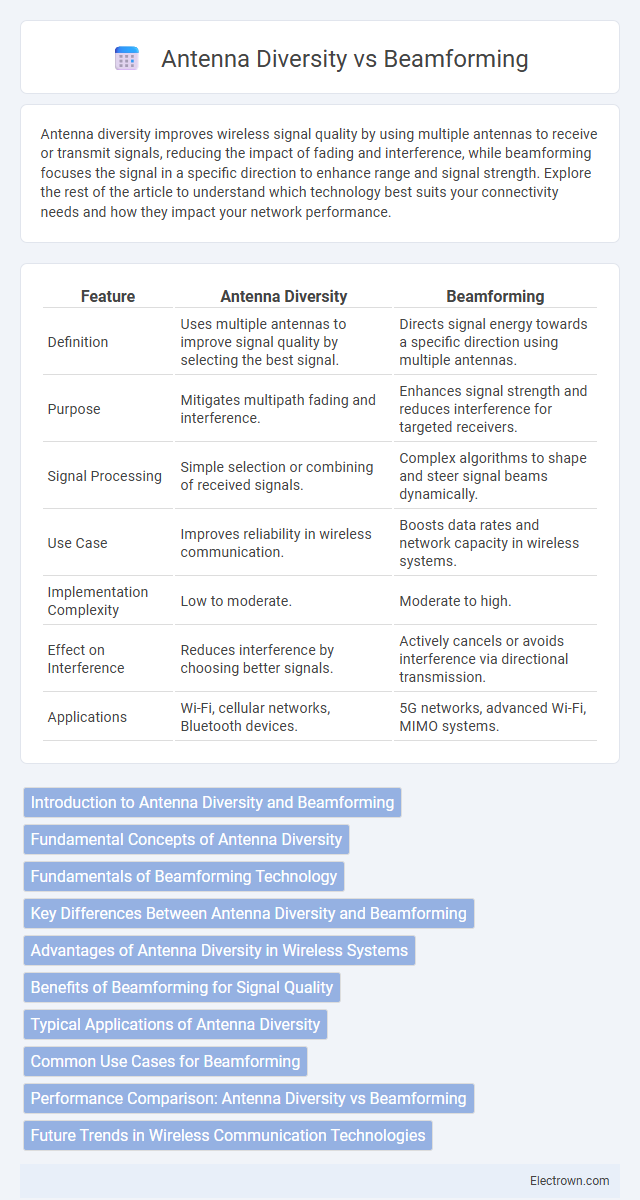Antenna diversity improves wireless signal quality by using multiple antennas to receive or transmit signals, reducing the impact of fading and interference, while beamforming focuses the signal in a specific direction to enhance range and signal strength. Explore the rest of the article to understand which technology best suits your connectivity needs and how they impact your network performance.
Table of Comparison
| Feature | Antenna Diversity | Beamforming |
|---|---|---|
| Definition | Uses multiple antennas to improve signal quality by selecting the best signal. | Directs signal energy towards a specific direction using multiple antennas. |
| Purpose | Mitigates multipath fading and interference. | Enhances signal strength and reduces interference for targeted receivers. |
| Signal Processing | Simple selection or combining of received signals. | Complex algorithms to shape and steer signal beams dynamically. |
| Use Case | Improves reliability in wireless communication. | Boosts data rates and network capacity in wireless systems. |
| Implementation Complexity | Low to moderate. | Moderate to high. |
| Effect on Interference | Reduces interference by choosing better signals. | Actively cancels or avoids interference via directional transmission. |
| Applications | Wi-Fi, cellular networks, Bluetooth devices. | 5G networks, advanced Wi-Fi, MIMO systems. |
Introduction to Antenna Diversity and Beamforming
Antenna Diversity enhances wireless signal quality by using multiple antennas to receive or transmit signals, effectively reducing interference and multipath fading. Beamforming directs the signal toward a specific receiver, improving signal strength and capacity by focusing the energy spatially. Both techniques play crucial roles in modern wireless communication systems, including Wi-Fi 6 and 5G networks, by optimizing signal reliability and network performance.
Fundamental Concepts of Antenna Diversity
Antenna diversity improves wireless communication reliability by using multiple antennas to capture signals from different paths, reducing the impact of fading and interference. Techniques such as spatial, pattern, and polarization diversity enhance signal quality by combining or switching between antenna inputs based on signal strength or quality metrics. Understanding these fundamental concepts helps you optimize your wireless system's performance in challenging environments.
Fundamentals of Beamforming Technology
Beamforming technology utilizes multiple antennas to direct signal transmission or reception toward specific directions, enhancing signal strength and reducing interference. It relies on controlling the phase and amplitude of signals at each antenna element to create constructive interference patterns, resulting in focused beams. This spatial filtering capability improves communication reliability and spectral efficiency compared to antenna diversity, which primarily selects the best signal from multiple antennas without directional focus.
Key Differences Between Antenna Diversity and Beamforming
Antenna diversity improves signal reliability by using multiple antennas to receive the same signal and selecting the best one to reduce fading and interference, while beamforming focuses the transmission and reception of signals in specific directions to enhance signal strength and reduce interference. Antenna diversity operates primarily to combat multipath and signal degradation, whereas beamforming steers beams dynamically towards desired users or devices for increased capacity and range. Beamforming requires advanced signal processing and array antennas, contrasting with the simpler switch or combiner methods used in antenna diversity systems.
Advantages of Antenna Diversity in Wireless Systems
Antenna diversity in wireless systems enhances signal reliability by using multiple antennas to receive or transmit signals, reducing the impact of multipath fading and interference. This technique improves your connection stability and coverage area without requiring complex beamforming algorithms. The low implementation cost and compatibility with existing hardware make antenna diversity a practical solution for enhancing overall wireless performance.
Benefits of Beamforming for Signal Quality
Beamforming significantly enhances signal quality by directing radio waves toward specific devices, which increases signal strength and reduces interference. This targeted transmission improves data throughput and reliability, especially in congested wireless environments. Unlike antenna diversity, which relies on selecting the best signal from multiple antennas, beamforming dynamically shapes the signal pattern to optimize communication efficiency.
Typical Applications of Antenna Diversity
Antenna diversity enhances wireless communication reliability by using multiple antennas to minimize signal fading, making it essential in mobile devices, Wi-Fi routers, and cellular base stations. It improves signal quality in environments with multipath interference, such as urban areas, indoor offices, and crowded venues. Your wireless systems benefit from antenna diversity by maintaining stable connections and reducing dropped calls or data loss.
Common Use Cases for Beamforming
Beamforming is widely used in wireless communication systems such as 5G networks, Wi-Fi 6, and advanced MIMO configurations to enhance signal strength and data throughput by directing signals towards specific devices. It is essential in environments with high user density, like stadiums, airports, and urban areas, where precise signal targeting reduces interference and improves network capacity. Beamforming also plays a critical role in smart home devices, IoT applications, and autonomous vehicles by enabling reliable, low-latency connectivity.
Performance Comparison: Antenna Diversity vs Beamforming
Antenna diversity improves wireless communication reliability by using multiple antennas to receive signals independently, effectively reducing fading and interference effects. Beamforming enhances performance by electronically directing signal transmission or reception toward specific users, increasing signal strength and spatial selectivity. Comparing both, beamforming offers superior throughput and range in dense environments, while antenna diversity primarily ensures robust connectivity in variable signal conditions.
Future Trends in Wireless Communication Technologies
Antenna diversity enhances signal reliability by using multiple antennas to mitigate fading and interference, while beamforming directs wireless signals towards specific users to increase network capacity and range. Future trends in wireless communication technologies emphasize integrating advanced beamforming with massive MIMO systems and machine learning algorithms for dynamic beam steering and interference management. These innovations are critical for accelerating 5G and enabling ultra-reliable low-latency communications (URLLC) and enhanced mobile broadband (eMBB) in 6G networks.
Antenna Diversity vs Beamforming Infographic

 electrown.com
electrown.com